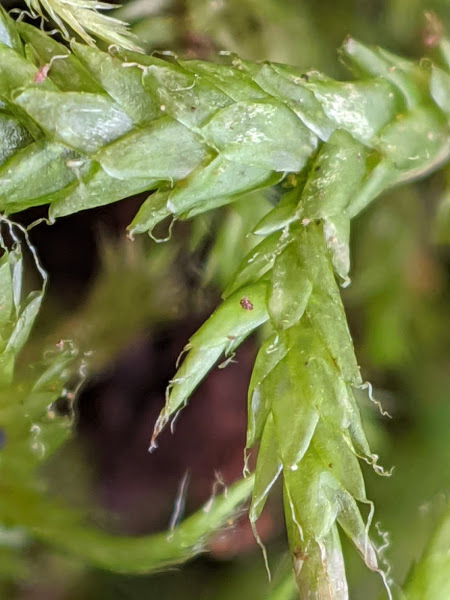Sematophyllaceae
Autoicous, synoicous (not in Victoria), dioicous or phyllodioicous (not in Victoria). Asexual reproduction by filamentous gemmae on stems and in leaf axils, or by caducous flagellate microphyllous branches. Mats or tufts on trees, logs, rocks, or soil. Stems creeping, irregularly or regularly pinnate to bipinnate, rarely simple, often with erect-ascendent branches, sometimes cuspidate, with rhizoids on ventral side; paraphyllia absent; pseudoparaphyllia absent or present and foliose or filamentous; central strand absent. Leaves arranged around stem and facing all directions, rarely complanate (not in Victoria), monomorphic or those of stems and branches differing, straight, homomallous, or falcate-secund to circinate, erect to wide-spreading when moist, scarcely altered or becoming more flexuose when dry; apex obtuse, acute or acuminate, sometimes with a hairpoint; costa absent or double and short or rarely extending to mid-leaf (not in Victoria), rarely single and extending to around mid-leaf (not in Victoria); margin entire to serrate, plane, reflexed, or involute, without or rarely with a border of more elongate cells (not in Victoria); laminal cells linear, smooth, prorulose or uni- or pluripapillose; alar cells well differentiated, rarely indistinct (not in Victoria), few or numerous in angles, elongate to quadrate, usually enlarged or inflated, hyaline or coloured. Pleurocarpous. Capsule erect to pendent, symmetric or curved, exserted, operculate, with or without an annulus; exothecial cells collenchymatous or not. Calyptra mitrate or cucullate, smooth, glabrous, rarely hairy near base (not in Victoria). Operculum conic (not in Victoria) or rostrate. Peristome double and alternate, or rarely single (not in Victoria); exostome of 16 entire teeth, shouldered or not; endostome of 16 segments or rarely absent (not in Victoria), when present with a high to low (not in Victoria) basal membrane; cilia present, rarely absent (not in Victoria).
Worldwide except Antarctica, with around 61 genera and 840 species; six genera and eleven species in Victoria.
The family Pylaisiadelphaceae was erected (Goffinet & Buck 2004) to accommodate several genera that have been placed in the Sematophyllaceae, but often lack a combination of features present in more typical Sematophyllaceae, such as capsules with collenchymous exothecial cells and furrowed exostome teeth (Carvalho-Silva et al. 2017). However, the Pylaisiadelphaceae have been shown in phylogenies of DNA sequences to comprise a series of lineages, several of which are closer related to a more narrowly circumscribed Sematophyllaceae than to other Pylaisiadelphaceae (e.g. Cox et al. 2010; Akiyama et al. 2011; Carvalho-Silva et al. 2014, 2017; Han & Jia 2020). Furthermore, there appears to be no set of characters that are exclusive to Pylaisiadelphaceae that can be used to consistently distinguish it from a more narrowly circumscribed Sematophyllaceae (Carvalho-Silva et al. 2017). The morphological overlap between the two families is exemplified by some of the former species of Sematophyllum being placed in the Pylaisiadelphaceae in phylogenies of DNA sequences (Carvalho-Silva et al. 2017).
A broad circumscription of Sematophyllaceae that includes Pylaisiadelphaceae, is monophyletic (e.g. Huttunen et al. 2012), and is frequently adopted (e.g. Schofield 2014; Fife 2016; Han & Jia 2020), and is followed here. While taking this broader approach has been argued against because of a lack of putative defining characteristics, such a groups distinctiveness is probably no less than groups within this broader group, such as the Pylaisiadelphaceae. The majority of Sematophyllaceae have leaves without a costa or with short and double costae, differentiated alar cells, and rostrate opercula.
 Spinning
SpinningAkiyama, H.; Chang, Y.; Yamaguchi, T.; Tan, B.C. (2011). Yakushimabryum longissimum (Pylaisiadelphaceae) gen. & sp. nov., from the Yakushima Island, Japan. Journal of Bryology 33: 42–49.
Carvalho-Silva, M.; Dantas, T.S.; Câmara, P.E.A.S. (2014). Systematic position of the moss genus Trachyphyllum A. Gepp. (Pylaisiadelphaceae) plus additions to its distribution in the Neotropics. Journal of Bryology 36: 217–222.
Carvalho-Silva, M.; Stech, M.; Soares-Silva, L.H.; Buck, W.R.; Wickett, N.J.; Liu, Y.; Câmara, P.E.A.S. (2017). A molecular phylogeny of the Sematophyllaceae s.l. (Hypnales) based on plastid, mitochondrial and nuclear markers, and its taxonomic implications. Taxon 66: 811–831.
Cox, C.J.; Goffinet, B.; Wickett, N.J.; Boles, S.B.; Shaw, A.J. (2010). Moss diversity: A molecular phylogenetic analysis of genera. Phytotaxa 9: 175–195.
Fife, A.J. (2016). Sematophyllaceae, in Heenan, P.B., Breitwieser, I. & Wilton, A.D. (eds), Flora of New Zealand- mosses. Fascicle 28. Manaaki Whenua Press, Lincoln.
Goffinet, B.; Buck, W. R. (2004). Systematics of the Bryophyta (Mosses): from Molecules to a Revised Classification. Monographs in Systematic Botany from the Missouri Botanical Garden 98: 205–239.
Han, W.; Jia, Y. (2020). Phylogeny and classification of the Sematophyllaceae s.l. (Hypnales, Bryophyta). *Journal of Systematics and Evolution * 59: 524–540.
Huttunen, S. et al. (2012). Disentangling knots of rapid evolution: origin and diversification of the moss order Hypnales. Journal of Bryology 34: 187–211.
Schofield, W.B. (2014). Sematophyllaceae, in Flora of North America Editorial Committee (eds), Flora of North America, vol. 28, pp. 571–583. Oxford University Press, New York.



